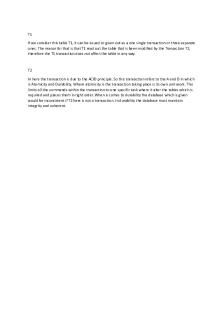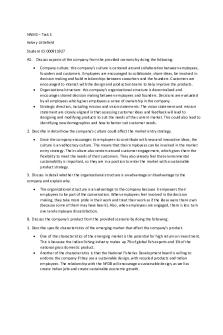QHT1 Task 1 DEMO - Pass First Try PDF

| Title | QHT1 Task 1 DEMO - Pass First Try |
|---|---|
| Course | Business Management Tasks |
| Institution | Western Governors University |
| Pages | 3 |
| File Size | 51.7 KB |
| File Type | |
| Total Downloads | 22 |
| Total Views | 165 |
Summary
Pass First Try...
Description
Business Management Tasks: Task 1 2019
A. When formulating quality considerations, there are three varying types of costs that must be carefully considered. The three varying costs are prevention costs, appraisal costs, and failure costs. Failure costs can be further broken down into external failure costs, and internal failure costs. B. Costs that are related to decreasing the chances for quality problems are knows as prevention costs. Prevention costs are related to stopping possible defects before they ever have a chance to occur. These types of costs include managerial and preparation systems, working alongside merchants, quality control, training, as well as extra detail orientation to the strategy and product assembly stages to further decrease the chance of product and service defects. An example of a prevention cost could be the creation and implementation of a new hire training program that covers the organizations expectations and overall quality standards. In addition to the new hire training, a semiannual refresher training course could be established and made mandatory for existing employees to further ensure company quality standards are continually adhered to. Yet another example of a prevention cost is to construct a new data analysis process in which known data about defects that have reoccurred on a regular/semiregular basis is compiled and analyzed to help pinpoint the cause of the defects and eliminate it so that the defects will not have a chance to continue. The next type of quality consideration cost are appraisal costs. Appraisal costs can be described as costs that are incurred during the quality certification process with the intention of uncovering defects in the system at all stages; including product manufacturing, product sale, and during all provided services. Said costs are considered investments to maintain the organizations quality excellence. There are several types of appraisal costs, such as testing, inspection, overall quality audits, and field testing. An example of an appraisal cost is when an organization must stop product production to allow an inspector to take product samples and conduct tests to confirm that all production requirements and standards are being met and that variation is not exceeding the expected/acceptable range. Yet another example of appraisal cost is to have additional product testing, once the product is fully assembled/complete to market standard and ensure that the product functions properly with
no apparent defects or problems. Such practices take both time and money but, as previously stated, this practice is an investment to further ensure acceptable product quality standards are met. The sooner any possible defects can be discovered, the less product is wasted and the more money the company can save. The third type of quality consideration cost are failure costs. Failure costs are costs resulting from defective products, unusable parts, or faulty services. This cost can be further broken down into two categories, internal failure costs and external failure costs. Internal failure costs are failures that are found during production. Internal failure costs include damaged equipment, damaged/unusable parts from wholesalers, invalid device settings on select equipment, employee negligence, and improper material handling procedures. The costs incurred by the above listed failures include material scrapping, possible equipment damage, employee injuries, and product rework/redo. An example of an internal failure is a fatigued employee does not input the correct settings/widget sizing into the manufacturing equipment and the wrong sized widget is produced. This failure would cause a great amount of unusable and wasted material and the incorrect widgets would either need reworked, if possible, or discarded. Another example is a dairy wholesaler selling a sandwich making company rotten or moldy cheese. The cheese would be unusable, and need thrown away. External failure costs are failures that are discovered by consumers after the product has left the manufacturer and has been purchased. These failure costs include customer complaints/negative response, possible lawsuits, warranty claims, refund demands or additional discounts. These costs are a result of low-quality parts/product, loss of customer approval, and decreases opportunity cost in the market resulting from lost transactions. An example of an external failure cost is a product that is purchased by a customer and when the customer opens the box, they discover severe denting and scratches on the outside of the product. The customer then demands either a refund on the product, or a significant discount on the damaged product with a free replacement provided. Following their experience, this customer shares a negative review online, as well as to their friends, family and coworkers. This situation results ibn several different external failure costs including fielding the complaint, providing a partial refund on the damaged item, replacement cost of the item, and loss of possible sales due to bad reviews by the disgruntled consumer.
C. The trade-offs with prevention costs are that training employees, both new and existing, as well as establishing new systems in the production process can be expensive and take a substantial amount of time. Employees, both new and existing, will have to be paid for their time spent in the additional training and the necessary equipment for the new production systems can be significantly costlier compared to the current equipment. The trade-off in this situation is that the allocation of resources becomes an investment in the company itself as they will decrease the number of overall product defects that occur in production. Better quality is assured, and standards are met before the production process can even begin. In addition to prevention costs, there are trade-offs with appraisal costs as well. One trade-off is that to do any sort of product/quality inspection, the company must temporarily stop production which causes a loss in both time and money. The time it takes for the inspection is time not spent making products, and therefore is money lost as there will not be as many products to sell. However, by having the inspection, the organization can find and stop possible defects before they get further in the production process or happen in more than just the sampled product. Like their above predecessors, failure costs also have trade-offs. Through internal failure costs, the organization can identify which pieces of their equipment are inadequate for production and make the necessary changes to prevent further defects. The identification of the malfunctioning equipment was only identifiable due to past defects and the pinpointing of where the defect occurred within the production process. Also, in the previous example with the fatigued employee, after the incident, management may see the need to hire additional workers so existing employees are not overworked to the point of extreme fatigue. External failure costs give the organization the chance to “make things up” with disgruntled customers who get a defective or damaged product. Through these types of interactions, customer service interactions are able to be improved upon and, in response, the company may gain back the favor of the customer if they are pleased with the customer service experience and the company’s response to the problem. A quick and effective response to complaints shows consumers that the company values their business and cares about their satisfaction....
Similar Free PDFs

DO94 Task 1 Pass on First Try
- 7 Pages

Qht1 task 1 - Task 1
- 3 Pages

Task 1 C228 WGU PASSED first TRy
- 13 Pages

First TRY
- 8 Pages

QHT1- Task 3 - Assignment
- 2 Pages

KBT2 Task 1 - Pass
- 7 Pages

QHT1 Task 2 - Task 2
- 1 Pages

C455 Task 1 - Grade: pass
- 4 Pages

D094 Task 1 - Easy pass
- 4 Pages
Popular Institutions
- Tinajero National High School - Annex
- Politeknik Caltex Riau
- Yokohama City University
- SGT University
- University of Al-Qadisiyah
- Divine Word College of Vigan
- Techniek College Rotterdam
- Universidade de Santiago
- Universiti Teknologi MARA Cawangan Johor Kampus Pasir Gudang
- Poltekkes Kemenkes Yogyakarta
- Baguio City National High School
- Colegio san marcos
- preparatoria uno
- Centro de Bachillerato Tecnológico Industrial y de Servicios No. 107
- Dalian Maritime University
- Quang Trung Secondary School
- Colegio Tecnológico en Informática
- Corporación Regional de Educación Superior
- Grupo CEDVA
- Dar Al Uloom University
- Centro de Estudios Preuniversitarios de la Universidad Nacional de Ingeniería
- 上智大学
- Aakash International School, Nuna Majara
- San Felipe Neri Catholic School
- Kang Chiao International School - New Taipei City
- Misamis Occidental National High School
- Institución Educativa Escuela Normal Juan Ladrilleros
- Kolehiyo ng Pantukan
- Batanes State College
- Instituto Continental
- Sekolah Menengah Kejuruan Kesehatan Kaltara (Tarakan)
- Colegio de La Inmaculada Concepcion - Cebu






